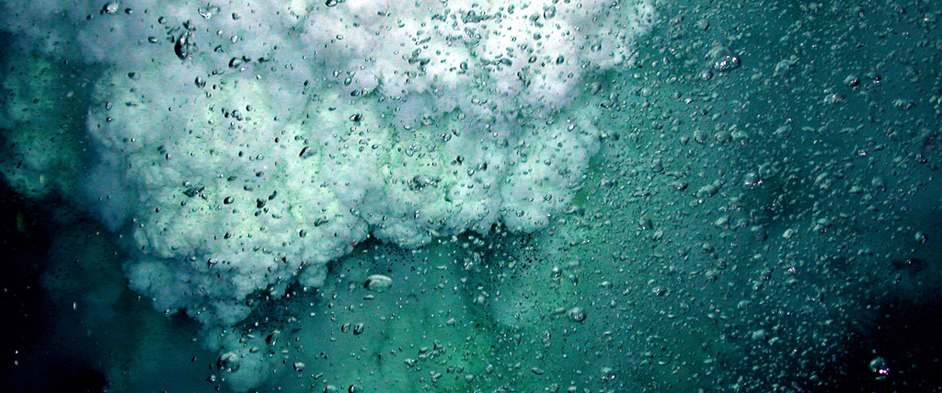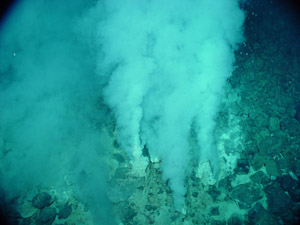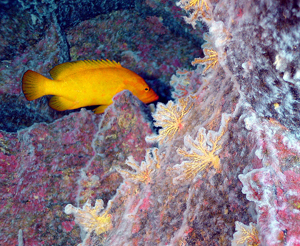MARIANAS TRENCH MARINE NATIONAL MONUMENT

“My dream as a child in Detroit was to help protect at least a small part of the world for the future’s kids. Little did I know that I’d be given the responsibility and privilege of helping to care for one of the largest, and arguably the most otherworldly place on Earth, at a time when history may be made and mankind gets our first good look at the bottom of the world with human eyes. Dreams do come true.” —Susan White, Marianas Trench Marine National Monument Superintendent, U.S. Fish and Wildlife Service
The Mariana Trench is five times longer than the Grand Canyon, deeper than Mount Everest is tall, and filled with phenomena that humans have yet to discover or fully understand. As part of the DEEPSEA CHALLENGE expedition James Cameron will dive to the Challenger Deep, the deepest point in the world, which is located at the southern end of the trench. But the region around the Mariana Archipelago is not only noteworthy for its depth; here you’ll find a pool of liquid sulfur, hydrothermal vents, some of the largest mud volcanoes on Earth, dense predator populations, and a realm where photosynthetic and chemosynthetic organisms can survive side by side.
To help preserve these unique environments, including the Sirena Deep, another of the world’s deepest points, the Marianas Trench Marine National Monument was established in 2009. As one of the world’s largest marine protected areas, the monument covers about 61 million acres (25 million hectares) of submerged lands and some of the waters above them—an area about the size of Wyoming. Managed primarily by the U.S. Fish and Wildlife Service (FWS), with coordination from the National Oceanographic and Atmospheric Association (NOAA), the monument is organized into trench, volcanic, and island units, each very different in their geography, biology, and the factors that are protected. Combined, the units include about 1,000 miles (1,600 kilometers) of the trench bottom itself, 21 undersea volcanoes, and the waters and submerged lands around three of the northern Mariana Islands (the monument does not include the islands themselves). This is indeed barely charted territory: Monument managers themselves are anxious for Cameron’s dives because they, too, expect to learn much more about the places they’re protecting.
From the sky this area may look like a curved string of beautiful islands, but this is also part of the Pacific Ring of Fire, the zone where tectonic plates move aggressively, where volcanoes seethe both above and below the water, and where 90 percent of the world’s earthquakes occur. Here are some of the fascinating features that have been found in the monument and the area around it so far:
- The Champagne vent. This is an undersea vent where liquid carbon dioxide bubbles out 20-inch-tall (50-centimeter-tall) chimneys that have sprouted on the underwater Eifuku volcano. The liquid coming out of these chimneys is 217°F (103°C). The only other place on Earth where liquid carbon dioxide has been observed is the Okinawa Trough in the East China Sea, but scientists believe that we could find more sites as we continue to explore the ocean.
- Liquid sulfur. In a cauldron 1,345 feet (410 meters) deep on the Daikoku submarine volcano, liquid sulfur churns in a pool that appears black. This phenomenon is rarely documented on Earth, but is also found elsewhere in the solar system; another known location of molten sulfur is hundreds of millions of miles away on Io, one of Jupiter’s moons.

Image courtesy NOAA Submarine Ring of Fire 2004 (Volcanoes Unit MTMNM) White flocculent mats in and around the extremely gassy, high-temperature (217°F, 103°C) white smokers at the Champagne vent.
- Life around deep hydrothermal vents. The monument’s complex geology provides a variety of deep vent habitats where organisms live in profusion far below the depth at which life is fueled by sunlight. Microbes that are able to oxidize certain materials (such as hydrogen sulfide in volcanic gases) produce carbohydrates and provide the base of a food chain that supports these communities—a process called chemosynthesis. A typical deep vent assemblage consists of layers of microorganisms employing chemosynthesis to grow, as well as dense aggregations of amphipods and copepods, which graze on the bacteria. Larger animals such as crabs, shrimp, gastropods, tubeworms, and cephalopods prey on the amphipods and copepods. These communities are dominated by invertebrates, but there are records of large aggregations of eels at some of these sites. Japanese scientists recently discovered a serpentinite seep supporting a vent community consisting of clams, corals, sea anemones, comb jellies, snails, and crabs at the Shinkai Seep Field just north of the Challenger Deep.
- Photosynthetic and chemosynthetic environments. Maug is an undersea caldera with a perimeter that rises unevenly above the water’s surface, forming three islands. Within the caldera, scientists have discovered a rare environment; here between about 330 feet (100 meters) deep and the surface, life is sustained by both photosynthesis and chemosynthesis. The caldera’s active hydrothermal vents provide the hydrogen sulfide, ammonia, and methane that certain bacteria and bacteria-like organisms use to generate energy. But the vents rise to within about 66 feet (20 meters) of the surface and are shallow enough that light can still penetrate, so phytoplankton, macroalgae, and the symbiotic zooxanthellae in corals here can still generate energy from sunlight.
- Biodiversity.The reefs around the islands of Farallon de Pajaros (also called Uracas), Maug, and Asuncion are incredibly biologically diverse—partly because of the interplay between photosynthetic and chemosynthetic species. NOAA scientists working with other science partners have found the waters around these northern islands and shoals in the archipelago have substantially higher large-fish biomass, including apex predators like sharks, than the southern islands and Guam. These relatively pristine coral reef ecosystems are objects of scientific interest and essential to the long-term study of tropical marine ecosystems.
- A study for reef adaptation and survival. Within the Maug caldera, hydrothermal vents emit hot, acidic water, but nearby coral reefs have adapted and thrive. Learning about how an ocean community responds to a lower pH environment can help scientists understand what might happen to other reefs around the world as ocean pH drops, thereby becoming more acidic. Oceans across the globe are absorbing atmospheric carbon dioxide, which increases their acidity. As additional carbon dioxide in the atmosphere causes ocean acidification globally, the Maug caldera could give scientists valuable insights for reef resilience into the future.
- Sirena Deep. At 10,809 meters (35,462 feet) down, this steep-walled canyon is another of the deepest points in the world’s ocean. Patricia Fryer, one of the members of the DEEPSEA CHALLENGE team, helped discover and map the area, which is about 124 miles (200 kilometers) east of the Challenger Deep, with her Hawaii Mapping Research Group in 1997 and 2001. Originally called the HMRG Deep after the science team that discovered it, Fryer enlisted the help of students in the Mariana Islands to give the site a name that would honor local culture, and the Sirena Deep was born. During a 2011 expedition to the monument, scientists from Scripps Institution of Oceanography, led by marine microbiologist and DEEPSEA CHALLENGE chief scientist Doug Bartlett, documented the presence of xenophyophores, some of the largest individual-celled organisms on Earth. The researchers found the life-forms at depths of up to 6.6 miles (10.6 kilometers) within the Sirena Deep. The previous depth record for xenophyophores was approximately 4.7 miles (7.6 kilometers). According to Bartlett, these cells host a wide variety of other organisms and essentially give scientists a new habitat to study.

Image courtesy NOAA Submarine Ring of Fire 2004 (Volcanoes Unit MTMNM) Chemosynthetic microbial mats cover red algae and coral, which are photosynthetic. Hydrothermal vent and coral reef communities are overlapping here at a depth of 623 feet (190 meters), something none of the scientists on the Submarine Ring of Fire Expedition have witnessed before.
The future of the Marianas Trench Marine National Monument
Administrators are working on an overarching management plan that will include guidelines for resource conservation, education and outreach, science and exploration, traditional cultural access, and law enforcement. The draft management plan is expected to be released for public review in the fall of 2013. Managers are working with an intergovernmental advisory council, local government representatives, and the public in development of the plan. Visit the monument’s website to follow progress on the management plan.
A variety of partners have come together to take care of the monument—the first in the world that protects a deep-ocean trench. The U.S. Fish and Wildlife Service is the overall manager through the National Wildlife Refuge System. FWS’s responsibilities include ensuring the conservation of the area, engaging partners and educating the public, and permitting and overseeing activities such as scientific research and exploration, among other things. NOAA’s National Marine Fisheries Service also ensures conservation of the area by overseeing the monument’s fisheries and the marine mammals and sea turtles that ply its waters. NOAA also explores and monitors the monument, works closely with partners and the public, and produces educational materials. Both NOAA and FWS consult with each other when doing their work, in addition to coordinating with the U.S. Coast Guard, the U.S. Department of Defense, the U.S. Department of State, and the local governments of the Commonwealth of the Northern Mariana Islands and Guam. Local citizens of the Mariana Islands, as well as interested people from around the world, are also involved in trench monument conservation management through nongovernmental partners. Finally, scientists contribute to conservation management by discovering and providing information about what creatures live in the trench, where they live, and how they survive in such extreme environments, and by assessing the ecosystem’s health as the climate and oceans change globally. Read more about deep-ocean conservation.



